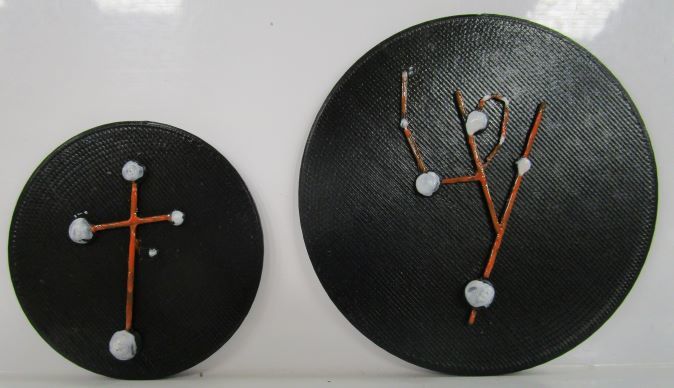
Tactile Constellations
thingiverse
Tactile Constellations ==================== These prints are a set of common constellations that can be seen in the Southern Hemisphere. They are shown in two ways, an Indigenous constellation and the matching Western constellation. Often the Western constellations are upside down in the Southern Hemisphere sky. Constellations are often used by astronomers to place other objects in the sky. The relative magnitude (brightness) of a star is shown by the size of the star. The lines connecting the stars represent the imaginary lines that people have 'drawn' in to make pictures with the stars. The stars are painted white and the lines are painted orange for increased contrast. They are approximately matched with respect to size, both with regards to the size of the stars and the distance of the stars from each other. ###Crux/Bunya Crux is the scientific name for the Southern Cross. It has 4 stars that are joined by two approximately perpendicular lines to make a cross. Bunya (Boon-ya) the possum sits in a tree and is a constellation from the Boorung people from north-west Victoria. Crux and Bunya are both around the same way.\ ###Orion/Djulpan Orion is a hunter from Greek mythology with bow to the right side and holding a club above his head with his left hand. The three stars close together in a row are known as Orion's belt. Djulpan is a constellation from the Yolngu people of Arnhem Land in the Northern Territory. The three stars of Orion's belt are three people sitting in a canoe. The ends of the canoe are formed by two bright stars. Another star represents a fish off the side of the canoe. ###Canis major/Warepil Canis major, or "The Great Dog", is the constellation which includes the brightest star in the sky, called Sirius. Sirius is the neck/collar of the dog. Viewed from the Southern Hemisphere, it looks like it's standing on it's nose. Warepil, the wedge-tailed eagle, is a constellation from the Boorung people from north-west Victoria. It includes Sirius, the brightest star in the sky, as the head of the eagle. ###Resources and references Stories in the Stars, Museum Victoria: https://museumsvictoria.com.au/scienceworks/learning/school-programs-and-resources/stories-in-the-stars/ Wikipedia page for Orion: https://en.wikipedia.org/wiki/Orion_(constellation) Wikipedia page for Canis Major: https://en.wikipedia.org/wiki/Canis_Major Wikipedia page for Crux: https://en.wikipedia.org/wiki/Crux Australia Indigenous Astronomy: http://aboriginalastronomy.blogspot.com/2011/07/djulpan-celestial-canoe.html
With this file you will be able to print Tactile Constellations with your 3D printer. Click on the button and save the file on your computer to work, edit or customize your design. You can also find more 3D designs for printers on Tactile Constellations.
